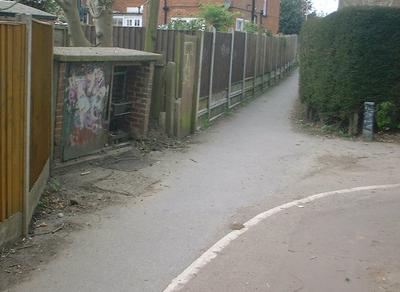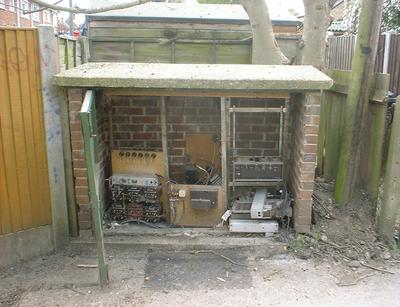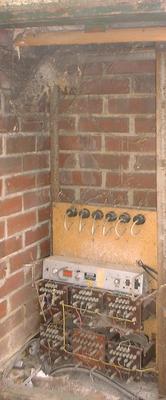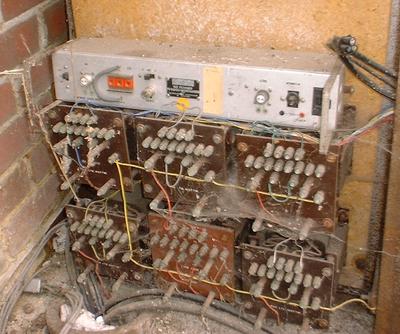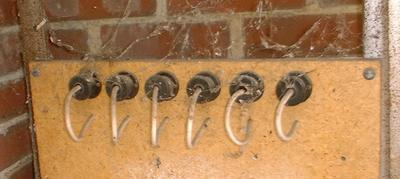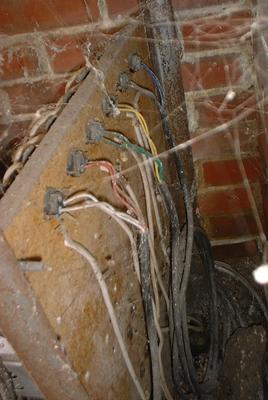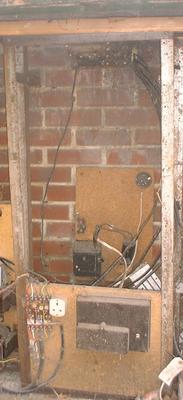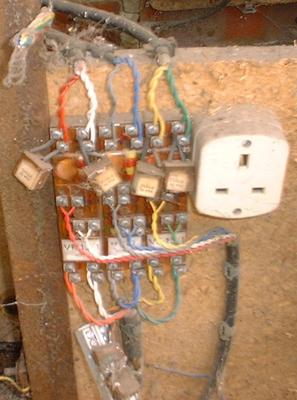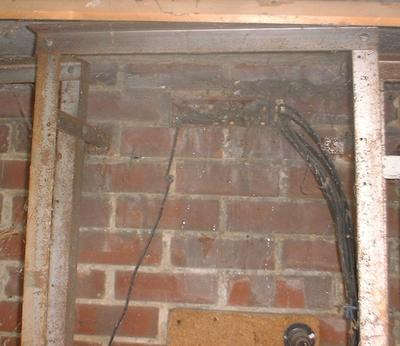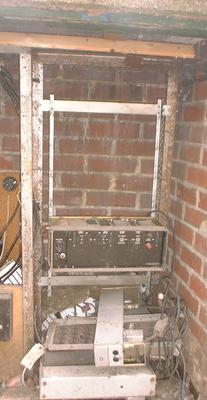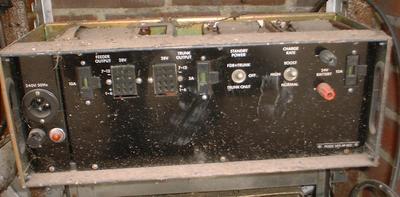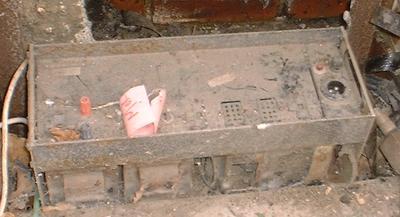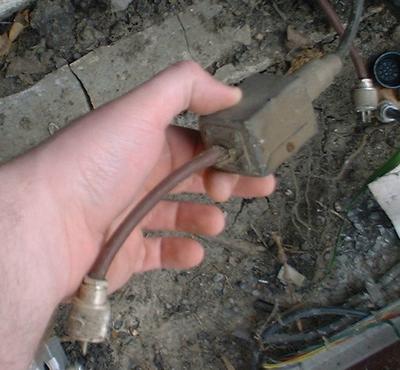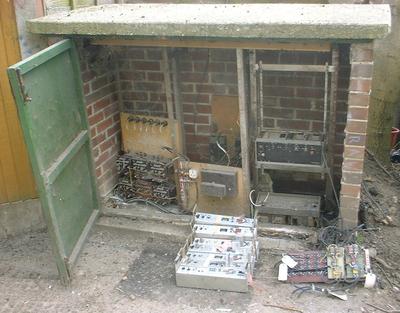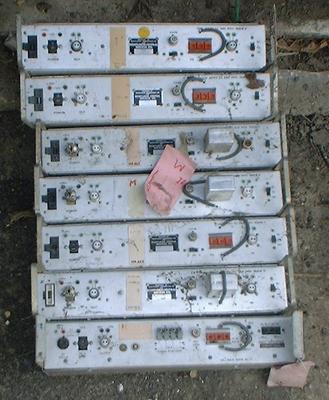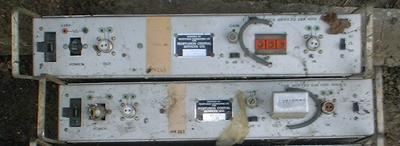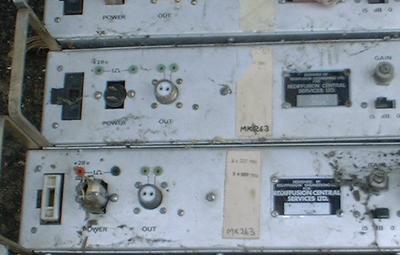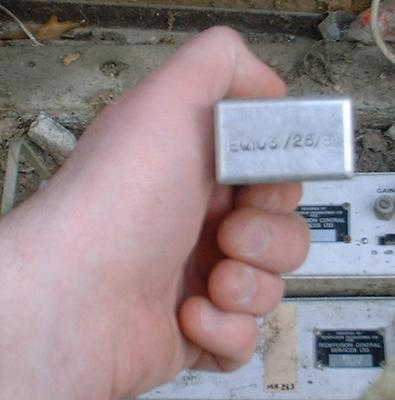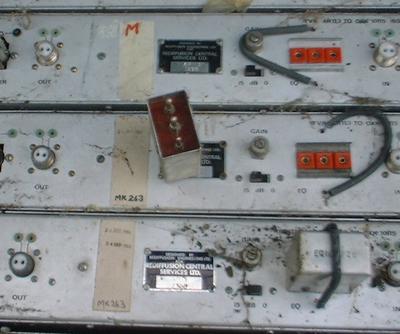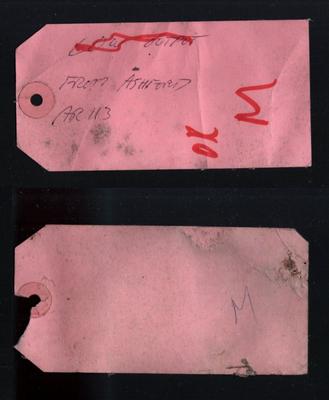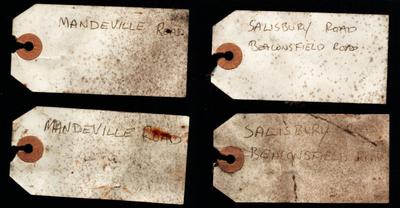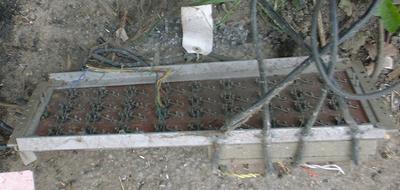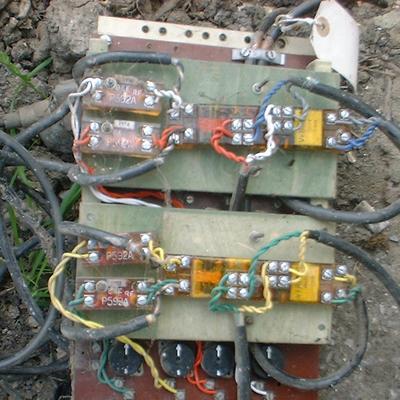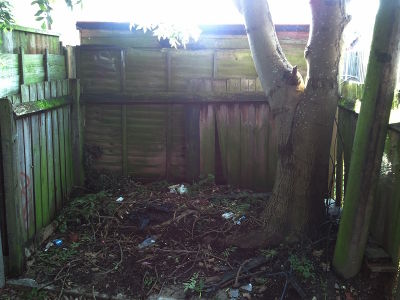Bob Mower contacted me in March 2007 to say that he'd found an open Rediffusion kiosk in Canterbury, and I went round to take some photos of the contents. I've actually walked past it many times without realising what it is; it's on one of the main cycle paths between the university and the city centre. To find it, go to the end of Mandeville Road, and walk down the alleyway to your right; it's the large brick cabinet just at the junction with the cycle path.
The kiosk is sitting in a little rectangular area cut out of the garden of the house behind. I wonder if Rediffusion bought the land, or if it's public property?
I don't know what happened to the other door, but I suspect human involvement (although, as Bob pointed out, it was extremely windy in the few weeks leading up to his discovery); it's fairly substantial, and I had difficulty getting the other door open. At first glance, time hadn't been particularly kind to this kiosk — although there was remarkably little rubbish inside.
This is obviously a pretty substantial piece of construction work. There's space inside for three relay racks of equipment — perhaps the previous generations of equipment were bulkier than what this kiosk ended up with. There are lots of obviously cut cables, and the contents have been moved around, but I think it's more or less complete.
The left rack
The left rack contains six extremely hefty transformers and six matching plugs and sockets. The Rediffusion system supported six channels; each trunk and subscriber cable contained seven twisted pairs, of which six were used. (The rackmount module has been moved from its rightful place; it wouldn't have been sitting here originally.)
The colour coding of the pairs is useful here again: that's one transformer per pair. The bottom centre one's different from the others; perhaps it's been replaced at some point.
Most of the cables enter through a hole at the bottom of the kiosk. The multiway plug at the left would have been connected to one of the power supplies.
Again, we have one socket per cable pair; I'll guess that they were provided so that pairs could easily be disconnected while they were being worked on.
I couldn't get my head around the back of the panel, but here's a photo; lots of coiled-up cables. There's another power supply plug on the floor there.
The centre rack
The centre rack is short to allow access to the power inlet behind it. The main fuse has been removed, and the mains wiring is in very poor condition. Would this have had an electricity meter originally, or would it have been charged as a constant load?
The consumer unit and a socket for tools are fixed to the rack, along with some potted filter modules similar to those in a house box. The cables have been cut so it's not obvious what these were connected to; perhaps they're the taps for the nearby houses.
I can't imagine that the proximity of these to the mains socket was ever a good idea — perhaps they were a late addition!
A few subscriber cables (presumably to the houses immediately behind) exit rather messily through a hole knocked in the airbrick at the back of the kiosk.
The right rack
The right-hand rack is where all the interesting stuff was — although not a lot of it was in place when I got there. It uses a neat mounting mechanism where each rackmount module has two fairly substantial pegs that clip into the rack. You can see in this photo that the only thing remaining in the rack was a power supply; everything else was (fortunately) at the back of the box under a pile of rubble.
The PU-522 power supply looked in remarkably good condition — very dirty (as you'd expect from having been exposed to the elements for a few weeks), but with its connectors bright and shiny and not a lot of rust. Looking inside it it appears to consist mostly of large transformers — it's a very heavy bit of equipment.
It looks like it'd provide 28V power to the other devices in the kiosk and down the trunk cables; there are also terminals and a charger for a standby battery bank in case mains power is lost. I couldn't see any sign of batteries or anywhere to put them in the box, so I assume this option wasn't used here.
A second PU-522 was sitting in the bottom of the kiosk below the first one, in considerably worse condition. I don't know if this was in use or just here as a spare. I could only see two of the multiway connectors sitting in the kiosk — but there is space for the second PU-522 in the rack underneath the first one.
I found a couple of these boxes with a twinax plug and socket in the bottom of the rack — I guess they're attenuators.
Rackmount equipment
I dug around in the rubbish at the back of the box and unearthed the missing contents of the racks.
In particular, these seven 2U rackmount devices, which must have come out of the rack on the right. Again, once the dust and cobwebs were blown off them, all of these looked in good condition.
Six of these are (mostly) identical AR 113 line amplifiers. They're very light boxes — definitely solid-state — and have a single input and output. There was one of these for each pair in the line, powered off the 28V output of the power supply.
Service labels attached indicate that these are all "Mk 263" revisions of the design, and were last serviced in the early-to-mid 1980s. The latest was dated 24th December 1986.
Each has a plug-in equalisation module held in by a spring. Some of these were still plugged in; others were in the bottom of the kiosk.
The seventh device is a DXJ 9414 — whatever that is. It's got twinax input and output connectors and an EQ module socket like the amplifiers above, but also has a terminal block for "sound injection". Perhaps this provided a 100V line sound-only service?
One of the AR 113s and the DXJ 9414 had pink paper tags attached,
presumably from the last time they were serviced; the DXJ 9414's just
said "M", and the AR 113's said "Low output From
Ashford AR 113 OK M".
Distribution panel
This panel was sitting on top of one of the power supplies, but it must have originally been fixed to one of the racks. It seems to have all the trunk cables connected to it, and a number of small plugin modules in valve-like sockets. (It didn't occur to me to investigate what the modules were, unfortunately.)
The cables at the left and right ends are labelled "Mandeville Road" and "Salisbury Road/Beaconsfield Road"; these must be trunk cables. A photo of the Salisbury Road box is on the Memories page.
Oddly, some connections are soldered directly to the back of the panel, which is otherwise quite simple. I suspect these are feeds to the tap modules on the centre rack.
Some more potted filter modules are fixed on pieces of plywood to one end of the panel — not a neat solution, since it obscures the existing connections.
RIP
After I took the photos above, I stacked the rackmount kit I'd removed back at the left end of the kiosk behind the remaining door to shield it more effectively from the weather. I needn't have bothered; within a couple of weeks the box and its contents had been removed.
As of October 2010, the fence is still there and the space is full of rubbish (thanks to Paul Andrews for the photo).
